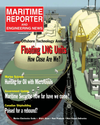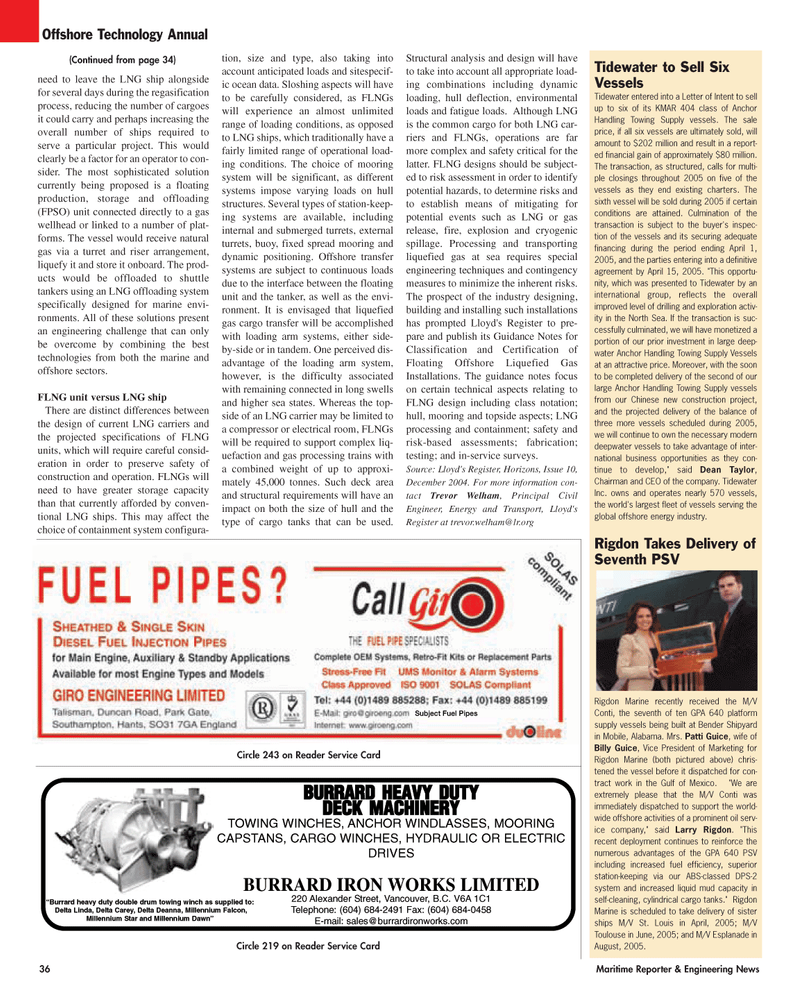
Page 36: of Maritime Reporter Magazine (April 2005)
The Offshore Industry Anual
Read this page in Pdf, Flash or Html5 edition of April 2005 Maritime Reporter Magazine
36 Maritime Reporter & Engineering News
Offshore Technology Annual need to leave the LNG ship alongside for several days during the regasification process, reducing the number of cargoes it could carry and perhaps increasing the overall number of ships required to serve a particular project. This would clearly be a factor for an operator to con- sider. The most sophisticated solution currently being proposed is a floating production, storage and offloading (FPSO) unit connected directly to a gas wellhead or linked to a number of plat- forms. The vessel would receive natural gas via a turret and riser arrangement, liquefy it and store it onboard. The prod- ucts would be offloaded to shuttle tankers using an LNG offloading system specifically designed for marine envi- ronments. All of these solutions present an engineering challenge that can only be overcome by combining the best technologies from both the marine and offshore sectors.
FLNG unit versus LNG ship
There are distinct differences between the design of current LNG carriers and the projected specifications of FLNG units, which will require careful consid- eration in order to preserve safety of construction and operation. FLNGs will need to have greater storage capacity than that currently afforded by conven- tional LNG ships. This may affect the choice of containment system configura- tion, size and type, also taking into account anticipated loads and sitespecif- ic ocean data. Sloshing aspects will have to be carefully considered, as FLNGs will experience an almost unlimited range of loading conditions, as opposed to LNG ships, which traditionally have a fairly limited range of operational load- ing conditions. The choice of mooring system will be significant, as different systems impose varying loads on hull structures. Several types of station-keep- ing systems are available, including internal and submerged turrets, external turrets, buoy, fixed spread mooring and dynamic positioning. Offshore transfer systems are subject to continuous loads due to the interface between the floating unit and the tanker, as well as the envi- ronment. It is envisaged that liquefied gas cargo transfer will be accomplished with loading arm systems, either side- by-side or in tandem. One perceived dis- advantage of the loading arm system, however, is the difficulty associated with remaining connected in long swells and higher sea states. Whereas the top- side of an LNG carrier may be limited to a compressor or electrical room, FLNGs will be required to support complex liq- uefaction and gas processing trains with a combined weight of up to approxi- mately 45,000 tonnes. Such deck area and structural requirements will have an impact on both the size of hull and the type of cargo tanks that can be used.
Structural analysis and design will have to take into account all appropriate load- ing combinations including dynamic loading, hull deflection, environmental loads and fatigue loads. Although LNG is the common cargo for both LNG car- riers and FLNGs, operations are far more complex and safety critical for the latter. FLNG designs should be subject- ed to risk assessment in order to identify potential hazards, to determine risks and to establish means of mitigating for potential events such as LNG or gas release, fire, explosion and cryogenic spillage. Processing and transporting liquefied gas at sea requires special engineering techniques and contingency measures to minimize the inherent risks.
The prospect of the industry designing, building and installing such installations has prompted Lloyd's Register to pre- pare and publish its Guidance Notes for
Classification and Certification of
Floating Offshore Liquefied Gas
Installations. The guidance notes focus on certain technical aspects relating to
FLNG design including class notation; hull, mooring and topside aspects; LNG processing and containment; safety and risk-based assessments; fabrication; testing; and in-service surveys.
Source: Lloyd's Register, Horizons, Issue 10,
December 2004. For more information con- tact Trevor Welham, Principal Civil
Engineer, Energy and Transport, Lloyd's
Register at [email protected]
Subject Fuel Pipes
Circle 243 on Reader Service Card
Circle 219 on Reader Service Card
Tidewater to Sell Six
Vessels
Tidewater entered into a Letter of Intent to sell up to six of its KMAR 404 class of Anchor
Handling Towing Supply vessels. The sale price, if all six vessels are ultimately sold, will amount to $202 million and result in a report- ed financial gain of approximately $80 million.
The transaction, as structured, calls for multi- ple closings throughout 2005 on five of the vessels as they end existing charters. The sixth vessel will be sold during 2005 if certain conditions are attained. Culmination of the transaction is subject to the buyer's inspec- tion of the vessels and its securing adequate financing during the period ending April 1, 2005, and the parties entering into a definitive agreement by April 15, 2005. "This opportu- nity, which was presented to Tidewater by an international group, reflects the overall improved level of drilling and exploration activ- ity in the North Sea. If the transaction is suc- cessfully culminated, we will have monetized a portion of our prior investment in large deep- water Anchor Handling Towing Supply Vessels at an attractive price. Moreover, with the soon to be completed delivery of the second of our large Anchor Handling Towing Supply vessels from our Chinese new construction project, and the projected delivery of the balance of three more vessels scheduled during 2005, we will continue to own the necessary modern deepwater vessels to take advantage of inter- national business opportunities as they con- tinue to develop," said Dean Taylor,
Chairman and CEO of the company. Tidewater
Inc. owns and operates nearly 570 vessels, the world's largest fleet of vessels serving the global offshore energy industry.
Rigdon Takes Delivery of
Seventh PSV
Rigdon Marine recently received the M/V
Conti, the seventh of ten GPA 640 platform supply vessels being built at Bender Shipyard in Mobile, Alabama. Mrs. Patti Guice, wife of
Billy Guice, Vice President of Marketing for
Rigdon Marine (both pictured above) chris- tened the vessel before it dispatched for con- tract work in the Gulf of Mexico. "We are extremely please that the M/V Conti was immediately dispatched to support the world- wide offshore activities of a prominent oil serv- ice company," said Larry Rigdon. "This recent deployment continues to reinforce the numerous advantages of the GPA 640 PSV including increased fuel efficiency, superior station-keeping via our ABS-classed DPS-2 system and increased liquid mud capacity in self-cleaning, cylindrical cargo tanks." Rigdon
Marine is scheduled to take delivery of sister ships M/V St. Louis in April, 2005; M/V
Toulouse in June, 2005; and M/V Esplanade in
August, 2005.
BURRARD HEAVY DUTY
DECK MACHINERY
TOWING WINCHES, ANCHOR WINDLASSES, MOORING
CAPSTANS, CARGO WINCHES, HYDRAULIC OR ELECTRIC
DRIVES
BURRARD IRON WORKS LIMITED 220 Alexander Street, Vancouver, B.C. V6A 1C1
Telephone: (604) 684-2491 Fax: (604) 684-0458
E-mail: [email protected] “Burrard heavy duty double drum towing winch as supplied to:
Delta Linda, Delta Carey, Delta Deanna, Millennium Falcon,
Millennium Star and Millennium Dawn” (Continued from page 34)
MR APRIL 2005 #5 (33-40).qxd 4/4/2005 3:25 PM Page 4

 35
35

 37
37
